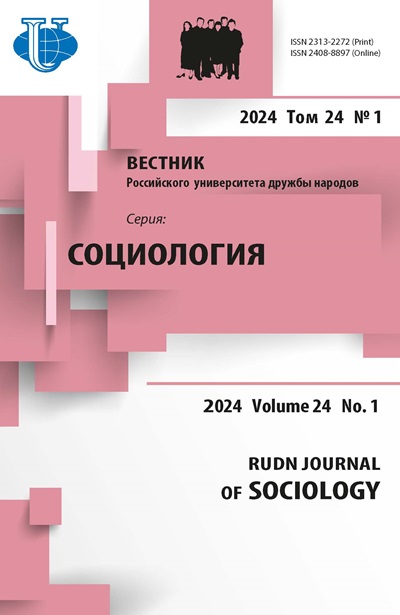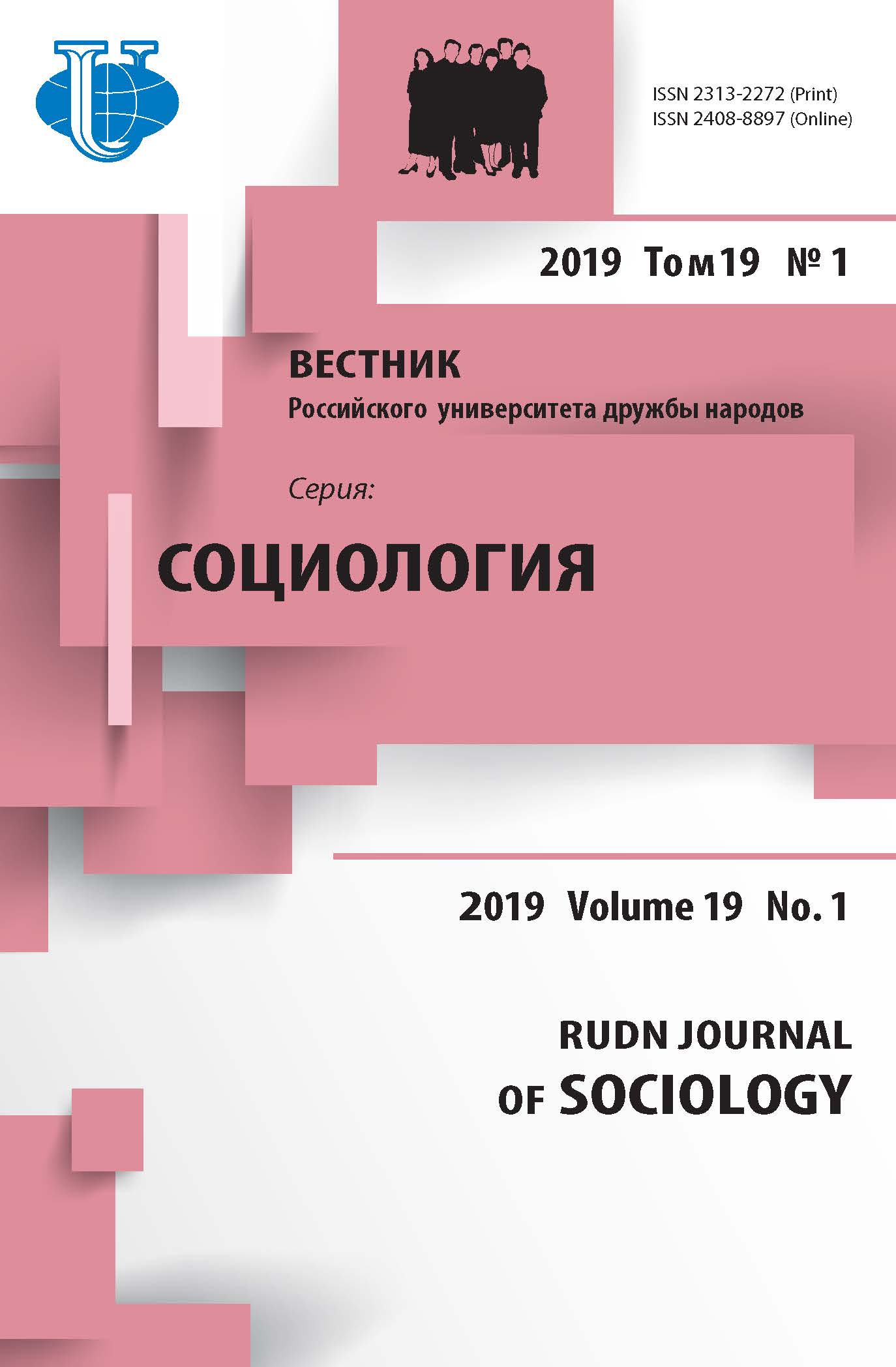Adaptation and immersion in the life trajectories of women engaged in prostitution
- Authors: Rusakova MM1
-
Affiliations:
- Saint Petersburg State University
- Issue: Vol 19, No 1 (2019)
- Pages: 71-80
- Section: Surveys, experiments, case studies
- URL: https://journals.rudn.ru/sociology/article/view/20557
- DOI: https://doi.org/10.22363/2313-2272-2019-19-1-71-80
Cite item
Full Text
Abstract
The author considers adaptation and immersion as parts of the life trajectory of women engaged in prostitution. This trajectory includes five stages: approach, entry, adaptation, immersion, and exit. The research aims at describing adaptation and immersion on the example of women engaged in prostitution in Saint Petersburg and Orenburg. The research had a mixed-method design consisting of a survey of 896 respondents and 10 semi-structured interviews (based on the ‘snowball’ sample). The article presents a descriptive analysis of the survey data and a thematic analysis of interviews. The study allowed to identify two trends in the respondents’ social environment: the loss of friendship and parent-child relationships, distancing and unwillingness to reveal their activities; the partnerships accompanied by the separation of activities in and out of prostitution. Women engaged in prostitution are subject to all forms of violence; therefore, an integral part of their adaptation and immersion is the recognition of clients’ behavior patterns and the development of safe interaction and conflict prevention strategies. The study also revealed the initiation and/or abuse of alcohol and drugs consumption in the course of activities in prostitution, and during immersion the severity of alcohol and drugs use tends to increase. Moreover, many women engaged in prostitution are in the poor psychological condition. Thus, it is necessary to further study prostitutes’ interaction with clients, sex business organizers, and the closest social environment not involved in sex business at all stages of the life trajectory in prostitution.
About the authors
M M Rusakova
Saint Petersburg State University
Author for correspondence.
Email: rusakova.maia@yandex.ru
кандидат социологических наук, доцент кафедры прикладной и отраслевой социологии Санкт-Петербургского государственного университета
Smolnogo St., 1/3, Saint Petersburg, Russia, 191124References
- Kurmanova G., Bashmakova E.P., Butenko E.N. Rabotniki kommercheskogo seksa [Workers of commercial sex]. Sociologicheskie Issledovaniya. 2000; 5 (In Russ.).
- Lyubov za dengi [Love for Money]. Pod red. V. Begalskoy, A. Vilkina. Moscow; 2017 (In Russ.).
- Pokatovich E.V., Matyushonok V.D. Tsenoobrazovanie na rynke onlain-prostitutsii [Pricing in the online prostitution market]. Ekonomicheskaya Politika. 2017; 12 (3) (In Russ.).
- Romanenko V. Transformatsiya sotsialnogo prostranstva zhenskoy prostitutsii (na primere molodykh zhenshchin, okazyvayushchikh seksualnye uslugi v Sankt-Peterburge) [Transformation of the social space of female prostitution (on the example of young women providing sexual services in Saint Petersburg). Zhurnal Sociologii i Socialnoj Antropologii. 2015; 18 (5) (In Russ.).
- Yakovleva A.A. Issledovaniya v trudnodostupnykh gruppakh: opyt ispolzovaniya vyborki, upravlyaemoy respondentom, i vyborki “mesto-vremya” [Research in hard-to-reach groups: Respondent-driven and time-location samples]. Sociologiya: Metodologiya, Metody, Matematicheskoe Modelirovanie. 2011; 33 (In Russ.).
- Ya-vedma [I am a witch]. Takie dela. 14.06.2018. 14https://takiedela.ru/2018/06/ya-vedma (In Russ.).
- Barton B. Managing the toll of stripping: Boundary setting among exotic dancers. Journal of Contemporary Ethnography. 2007; 36 (5).
- Brewis J., Linstead S. ‘The worst thing is the screwing’: Consumption and the management of identity in sex work. Gender, Work & Organization. 2000; 7 (2).
- Chapkis W. Power and control in the commercial sex trade. Sex for Sale: Prostitution, Pornography, and the Sex Industry. R. Weitzer (Ed.). New York; 2010.
- Chen X.S., Yin Y.-P., Liang G.-J., Gong X.-D., Li H.-S., Poumerol G. et al. Sexually transmitted infections among female sex workers in Yunnan. AIDS Patient Care & STDs. 2005; 19 (12).
- Dalla R.L. “You can't hustle all your life”: An exploratory investigation of the exit process among street-level prostituted women. Psychology of Women Quarterly. 2006; 30 (3).
- Dank M.L. Estimating the Size and Structure of the Underground Commercial Sex Economy in Eight Major US Cities. Washington; 2014.
- Deering K., Amin A., Shoveller J., Nesbitt A., Garcia-Moreno C., Duff P. et al. A systematic review of the correlates of violence against sex workers. American Journal of Public Health. 2014; 104 (5).
- Karandikar S., Prospero M. From client to pimp male violence against female sex workers. Journal of Interpersonal Violence. 2010; 25 (2).
- Malta M., Magnanini M., Mello M., Pascom A., Linhares Y., Bastos F. HIV prevalence among female sex workers, drug users and men who have sex with men in Brazil: A systematic review and meta-analysis. BMC Public Health. 2010; 10 (1).
- Mandiuc A. The impact of a prostitute mother on the child life circumstances. European Journal of Research on Education. 2014; 2 (2).
- Oselin S.S. Leaving Prostitution: Getting Out and Staying Out of Sex Work. New York; 2014.
- Raphael J., Myers-Powell B. From Victims to Victimizers: Interviews with 25 Ex-pimps in Chicago. Chicago; 2010.
- Sanders T. A continuum of risk? The management of health, physical and emotional risks by female sex workers. Sociology of Health & Illness. 2004; 26 (5).
- Sanders T., Campbell R. Designing out vulnerability, building in respect: Violence, safety and sex work policy. British Journal of Sociology. 2007; 58 (1).
- Shannon K., Strathdee S., Goldenberg S., Duff P., Mwangi P., Rusakova M. et al. Global epidemiology of HIV among female sex workers: Influence of structural determinants. Lancet. 2015; 385 (9962).
- Thomas J.C., Tucker M.J. The development and use of the concept of a sexually transmitted disease core. Journal of Infectious Diseases. 1996; 174 (2).
- Vanwesenbeeck I. Prostitutes’ Well-Being and Risk. Amsterdam; 1994.
- Weitzer R. Sociology of sex work. Annual Review of Sociology. 2009; 35.
- Whittaker D., Hart G. Research note: Managing risks: The social organization of indoor sex work. Sociology of Health & Illness. 1996; 18 (3).
- Williamson C. Entrance, Maintenance, and Exit: The Socio-Economic Influences and Cumulative Burdens of Female Street Prostitution. Indianapolis; 2010.














